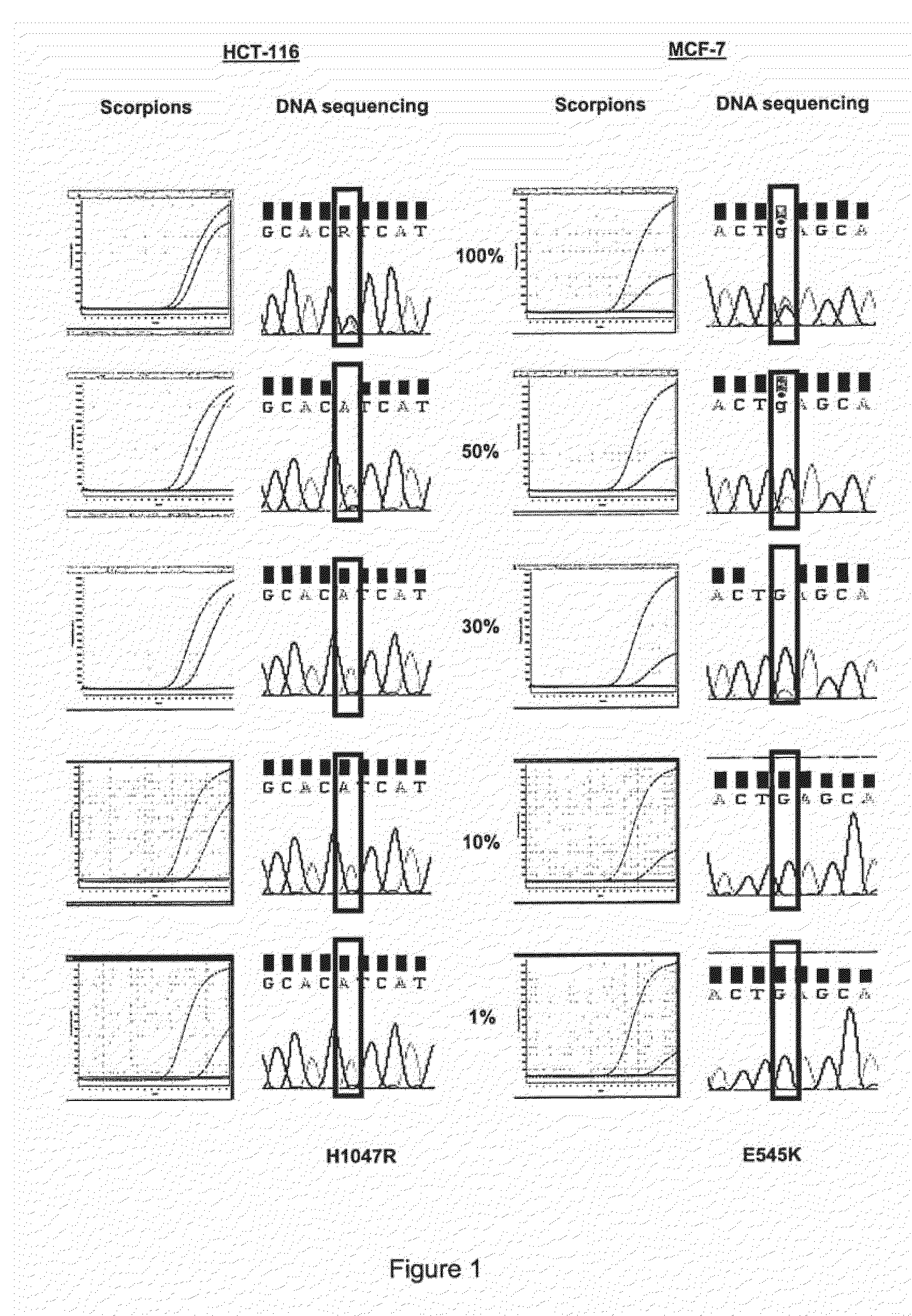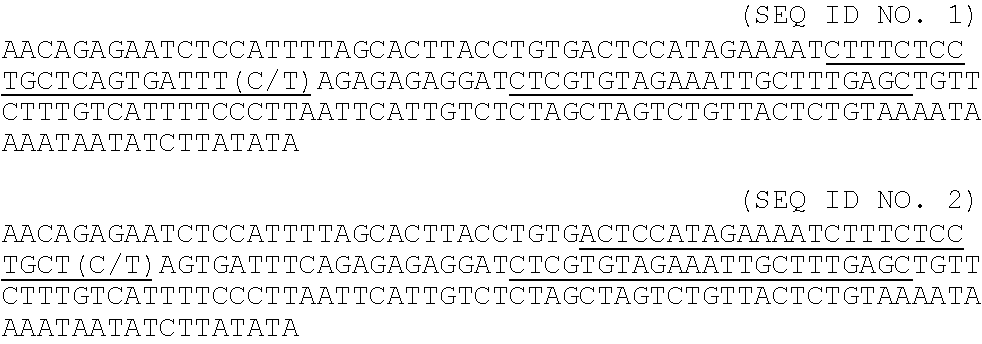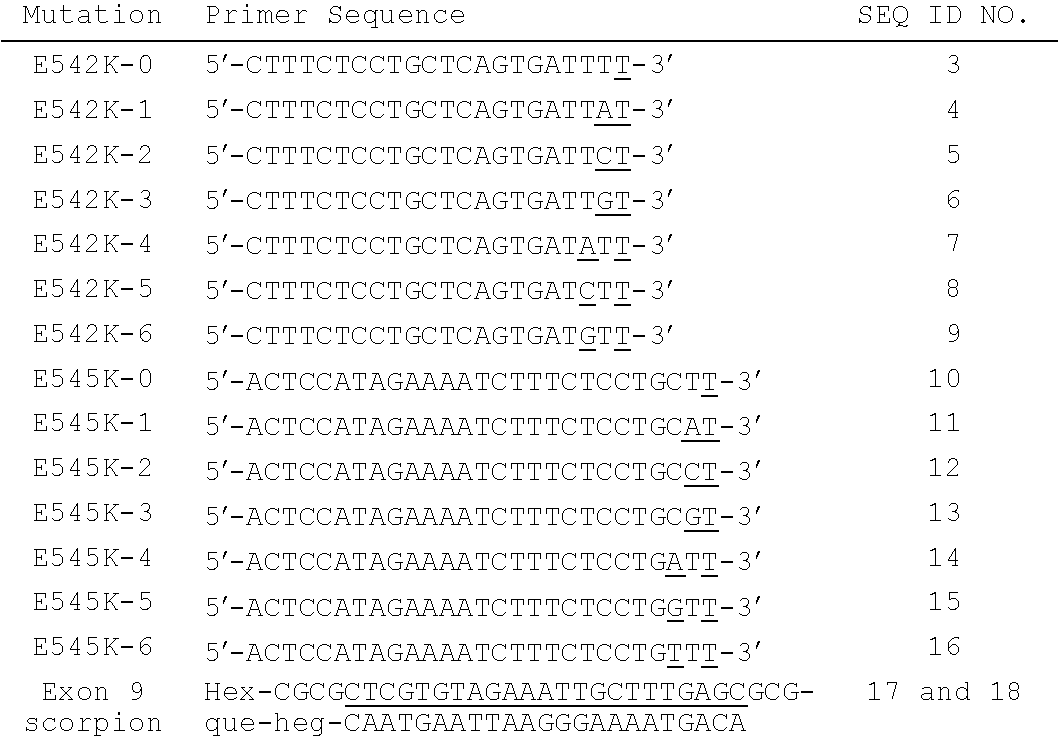Polynucleotide primers
a technology of polynucleotide and primer, which is applied in the field of polynucleotide, can solve the problems of poor quality, degraded dna extracted from paraffin embedded tissue, and abnormal cell growth, proliferation and survival,
- Summary
- Abstract
- Description
- Claims
- Application Information
AI Technical Summary
Benefits of technology
Problems solved by technology
Method used
Image
Examples
example 1
[0061]To determine the specificity of the reactions and the primers each assay was performed with 5-50 ng of genomic DNA per reaction to assess breakthrough signal caused by extension of mismatched primer. For each reaction a ΔCt value (control Ct− mutation Ct) was defined (Ct=threshold cycle). The reactions were performed six times for each DNA concentration and repeated in triplicate on separate occasions to define a cut off ΔCt value below which any amplification can be said to be due to the presence of mutant sequence and not due to breakthrough signal. The cut off ΔCt value was determined to be 1 Ct below the lowest ΔCt value seen in all reactions for each assay. For H1047R and H1047L assays the cut off ΔCt was defined as 12, for the E542K assay the cut off ΔCt was 9 and for the E545K assay the cut off ΔCt was 8.
example 2
[0062]To assess the sensitivity of the assay, 5 copies of mutant DNA were diluted in varying concentrations of genomic DNA to give final concentrations of 5, 2, 1, 0.5 and 0.1% mutant DNA to wild type. Table 1 illustrates the sensitivity of the 4 ARMS assays. The table shows the ΔCt values for reducing concentrations of mutant DNA within a background of wild type DNA. The predefined cut off ΔCts are illustrated in the final column. The exon 20 assays were able to detect 5 copies of mutant DNA when this comprised only 0.1% of the total DNA (within the previously defined cut off ΔCt). The exon 9 assays were able to detect 5 copies of DNA at 1% concentration with a ΔCt within the predefined cut off values (Table 1).
TABLE 1MUTWT DNA / DNA / Relativereactionreaction% ofΔCTCUT OFF(copies)(copies)MUT allelesH1047LH1047RE542KE545KΔCt10055%5.94.35.15.825052%7.26.77.26.4H1047L1250051%8.37.68.47.0H1047R12100050.5% 9.39.010.28.1E542K9500050.1% 11.510.512.110.1E545K8
example 3
[0063]Admixtures of cell lines containing mutation H1047R (HCT-116) and E545K (MCF-7) were used to compare the relative sensitivities of the ARMS assays compared with sequencing. Both cell lines were heterozygous for the mutation. Sequencing was performed using primers and PCR cycling conditions as described by Samuels et al[1]. ARMS assays and sequencing were carried out at concentrations of the mutant gene of 100%, 50%, 30%, 10% and 1% of the total mixture. The results are shown in FIG. 1 in which the results under the heading “Scorpions” show the increase in amplicon copy number after successive rounds of PCR (results using control primers and mutant primers are shown as separate lines). Under the heading “DNA Sequencing” is shown the results of sequencing the reverse strand of the gene in the mixture. Sequencing was not able to detect the presence of H1047R mutant when present at less than 50% of the total mixture and was unable to detect the presence of E545K mutant when presen...
PUM
| Property | Measurement | Unit |
|---|---|---|
| volume | aaaaa | aaaaa |
| wavelength | aaaaa | aaaaa |
| concentration | aaaaa | aaaaa |
Abstract
Description
Claims
Application Information
 Login to View More
Login to View More - R&D
- Intellectual Property
- Life Sciences
- Materials
- Tech Scout
- Unparalleled Data Quality
- Higher Quality Content
- 60% Fewer Hallucinations
Browse by: Latest US Patents, China's latest patents, Technical Efficacy Thesaurus, Application Domain, Technology Topic, Popular Technical Reports.
© 2025 PatSnap. All rights reserved.Legal|Privacy policy|Modern Slavery Act Transparency Statement|Sitemap|About US| Contact US: help@patsnap.com



